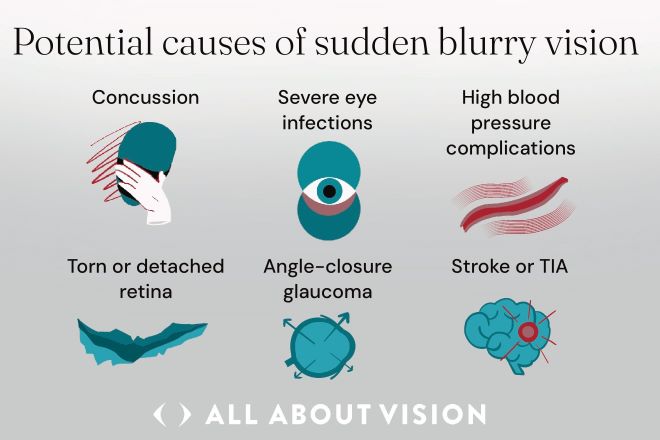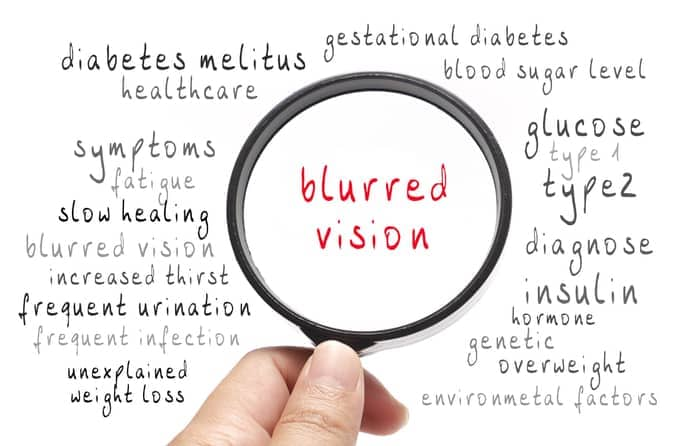Blurry vision causes
Your vision can become blurry for one or more reasons and affect your daily life in different ways.
An eye doctor or physician can help you get an accurate diagnosis and treatment.
Possible causes of blurred vision include:

Eye strain
Eye strain can happen when your eyes are closely focused on something for a while. Blurry vision is one possible symptom, along with:
The medical term for eye strain is asthenopia. You might feel it while you use a computer, cell phone or other digital device. It can also happen when you drive, read a book or do other tasks that require constant focus.
Eye strain is common in today's digital world. It can happen because:
You aren't blinking enough (common during screen use).
You're too close or far from the object you're looking at.
There isn't enough light or contrast.
There's glare on your screen.
You need new prescription glasses or contact lenses.
You may be able to help your blurry vision by updating your vision prescription, taking breaks with the 20-20-20 rule or using artificial tears. Being mindful about blinking enough and closing your eyes for rest breaks may also help.
Nearsightedness, farsightedness and astigmatism
Common eyesight problems called refractive errors make things look blurred and out of focus in different ways:
They are usually due to the shape of your eye, the shape of your cornea or both. If a refractive error is the problem, a pair of prescription glasses or contacts should get rid of your blurry vision. An eye doctor will give you a prescription after a routine eye exam.
SCHEDULE NOW: Book an eye exam with an eye doctor near you
Presbyopia
Presbyopia is also a refractive error, but it's caused by natural eye changes as you get older. It happens to everyone eventually.
You may start to notice these changes sometime in your 40s:
Difficulty focusing on close-up objects
Words look blurry at the usual reading distance
Difficulty seeing at night or in dim light
You have to hold reading material farther away to read it
Reading glasses and glasses with multifocal lenses are two popular ways to help presbyopia. Lens implants with bifocal and trifocal capability are another option.

Someone with normal vision would see crisp edges and vibrant colors in this scene.

A Jack Russell terrier, viewed by someone who has blurry vision

To someone who has cataracts, this scene could appear blurry, cloudy and/or slightly yellowed.
Dry eyes
Dry eye disease is a growing problem. It now affects more than 15 million Americans, according to one study.
Dry eyes can cause blurry vision and:
In addition to other reasons, your eyes can dry out from dehydration, screen overuse, inflamed eyelid oil glands and certain diseases that affect your eyes or entire body.
Migraine
Some people get blurry eyesight during a migraine attack. Other possible symptoms include:
Around 1 in 3 people with migraines experience an aura before their headache starts. The effects usually last between five minutes and an hour.
Auras can cause:
A blind or blurry spot in your vision
Flashes of light, zigzag shapes and other eyesight disturbances
Numb or tingly feelings in your face and body
Difficulty talking
Dizziness or balance problems
Auras shouldn't be confused with ocular migraines, a rare condition that can cause a blind spot or temporary blindness in one eye.
READ MORE: Blurry vision and headaches
Contact lenses
There's more than one way contacts can make your vision blurry:
They're dirty and need to be cleaned.
They (or your eyes) are too dry.
Your contact prescription is outdated.
You're still adjusting to a new prescription or lens type.
You sleep in your contacts or wear them too long during the day.
Your toric (astigmatism) contacts rotate out of position.
Sudden blurred vision, pain, redness and discharge can be signs of a serious eye infection. Talk to your doctor if you experience any of these symptoms.
Stress and anxiety
Stress causes all sorts of physical and mental symptoms, and temporary blurred vision can be one of them.
Blurry eyesight and other stress-related vision changes may be connected to the hormones your body releases when it's under stress.
Some studies have shown that stress and trauma can make it harder for your eyes to focus on distant objects in particular. You're more likely to notice this if you have generalized anxiety disorder.
Concussion
About 9 in 10 people with a traumatic brain injury have symptoms that affect their eyesight.
The most common brain injury is a concussion. It can cause symptoms like:
Blurry or double vision
Headache
Dizziness or problems balancing
Nausea or vomiting
Feeling tired or sluggish
Feeling confused
Feeling "off," depressed or like something is wrong
Concussion symptoms usually start shortly after you're hurt, but they can also take hours or days to show up. Get medical help right away if you notice any of the concussion symptoms above or any of these danger signs:
Slurred speech
Weakness or numbness
Confusion
Unequal pupil size
Shaking or seizures
Eye infection
An infection on, inside or around your eye can make your eyesight blurry.
Pink eye (conjunctivitis) is the most common eye infection. It can be caused by viruses or bacteria — both are very contagious.
Viral and bacterial pink eye symptoms can include:
Fuzzy vision
Eye redness (one eye may become red a few days before the other)
Itching, burning or a feeling that something is stuck in your eye
Light sensitivity
Watering
Eye pain (usually bacterial)
Thick, sticky eye discharge (bacterial)
Viral pink eye usually gets better on its own, but you may need treatment if it's bacterial. Eye doctors usually prescribe antibiotic eye drops for this. Eye allergies can also cause conjunctivitis, but the allergic form isn't an infection.
Other eye infections can cause blurred vision, too. Some of them are serious, including:
Infectious keratitis – A cornea infection caused by bacteria, fungi, parasites or herpes viruses.
Uveitis – Swelling in the middle layer of your eye (uvea) sometimes caused by an infection.
Endophthalmitis – Inflammation caused by an infection inside your eye.
Severe eye infections should be diagnosed and treated as quickly as possible. Without treatment, they can permanently damage your vision.
READ MORE: How different eye infections are treated
Pregnancy
Blurry vision is common during pregnancy. This is because certain hormones make the body — including the eyes — retain more water.
Fuzzy vision usually goes away within a few weeks of delivery.
Blurred vision can also be one of the symptoms of a complication:
These conditions usually go away after delivery, but they have to be treated during pregnancy. Without treatment, they can lead to serious, sometimes life-threatening problems for both mothers and their unborn babies.
Medications
Certain medicines can cause fuzzy vision and other eye problems as a side effect or complication.
The blurriness may go away on its own or need separate treatment. But some drugs can lead to permanent vision changes.
Medications that can cause blurry vision include:
Antihistamines – Medicines usually used to treat allergy symptoms. They can cause dry eye, which causes blurry vision. They can also raise the risk of developing glaucoma.
Steroids – Drugs that help lower inflammation. They can be taken as pills, injections, inhalers or nasal sprays. They're also used directly on the skin or eyes. Steroids can put you at higher risk of developing cataracts and glaucoma.
Antimalarials – Medicines that treat malaria but can also help conditions like lupus and arthritis. They can damage the retina, especially when they're taken in higher doses over longer periods.
READ MORE: Other medications that can cause vision problems
Cataracts
Cataracts can affect anyone, but they happen more often in older people. Most people have had at least one cataract by age 80.
A cataract can cause blurry vision and other eyesight problems as it gets worse. It can also cause:
New vision prescriptions may help your blurry vision for a while. Many people consider cataract surgery when the symptoms start to interfere with their daily lives.
You may notice blurred vision right after surgery, too. This is usually just a temporary side effect.
If it's been a while since surgery, a posterior capsule opacification (PCO) could be causing the blurriness. PCO is often called a "secondary cataract," but it's not a true cataract. Eye doctors can treat it with a quick laser procedure.
Diabetes
People with diabetes are at risk for diabetic eye disease and other problems that can affect their eyesight.
Blurred vision can be a symptom of:
Diabetes can also lead to cataracts or glaucoma. Both problems can cause blurry vision, but it's a much more common symptom of cataracts.
High blood pressure
High blood pressure can lead to problems that cause blurry vision and other symptoms.
Some of these conditions are:
Hypertensive retinopathy – A problem with the way blood flows to a thin layer of cells inside the eye (the retina ).
Hypertensive optic neuropathy – Swelling along the main pathway between the eyes and brain (the optic nerve).
Retinal vein or artery occlusion – A blood vessel blockage to or away from the retina that makes your vision suddenly blurry in one eye.
Stroke – A blood clot or burst blood vessel in the brain.
READ MORE: Can COVID-19 make your vision blurry?
Eye injury
An eye injury can make your vision blurry in different ways, depending on what happened. The visual effects can be temporary or, in some cases, permanent.
One of the most common eye injuries is a corneal abrasion — a scratch on the clear, front part of your eye.
A scratch doesn't always feel like an injury, but your cornea is very sensitive. Something as small as a grain of sand can eventually lead to uncomfortable symptoms.
A corneal abrasion can cause blurry vision and:
Some abrasions can lead to an infection if they aren't treated properly.
Other injuries can damage different parts of your eye. These include bleeding inside your eye, a detached retina and other complications.
Some of these problems can cause permanent eyesight damage if they aren't treated quickly. Talk to a doctor if you notice fuzzy vision or other eyesight changes after an injury.
Torn or detached retina
Sometimes, the retina rips (retinal tear) or pulls away from the back of the eye (retinal detachment). These problems can threaten your eyesight if they aren't treated quickly.
They can cause:
Sudden blurry vision
Flashing lights in your eyesight
Many new eye floaters (drifting dark or blurry spots in your vision)
A shadow or "curtain" over part of your vision
Call an eye doctor right away if you notice these symptoms.
Psoriasis
Studies show that psoriasis causes eye problems in as many as 1 in 8 people who have the disease. Most are men.
The two most common problems are dry eye syndrome and blepharitis (itchy, swollen eyelids), which is the number one cause of dry eyes. Both can cause blurry vision.
Psoriasis can also raise the risk of developing other problems that cause blurred vision, such as:
Macular degeneration
Age-related macular degeneration (AMD) can cause blurriness in the center of your vision.
There are two types of the disease: wet and dry. They don't cause symptoms early on.
Blurriness usually happens during the late stage of AMD (both types), but mild blurring can also happen during the intermediate stage of dry AMD.
People with AMD can also notice:
Wavy lines that should look straight
Difficulty seeing in low light
Colors that aren't as bright as they used to be
Blank spots in their vision
Glaucoma
Glaucoma is damage to the optic nerve (typically from high eye pressure) that connects each eye to your brain. The most common type is called primary open-angle glaucoma.
In many people, this type doesn't cause symptoms until they notice peripheral (side) vision loss.
There are ways to manage the disease, but without regular eye exams, permanent damage can go unnoticed for years.
Angle-closure glaucoma is a less common type, but it's an emergency that needs treatment right away. It comes on suddenly and causes symptoms like:
Neurological and brain disorders
Your eyes need your brain and nerves to give you sight. When there's a problem with one of these two areas, it can affect your vision.
A few of these conditions are:
Multiple sclerosis (MS) – The thin covering around the nerves wears away over time. MS often triggers swelling or damage to the optic nerve (optic neuritis) and other problems that can make eyesight blurry.
Parkinson's disease – Certain brain cells slowly wear down and make it harder to produce a chemical called dopamine. This can lead to blurry vision in different ways.
Brain tumor – A group of cancerous or non-cancerous cells form a mass in the brain. Some tumors cause blurred vision or other problems with eyesight.
Stroke or TIA
A stroke happens when there's a blood vessel clot or rupture in your brain. It's a potentially life-threatening emergency that needs to be treated right away.
A stroke can cause sudden blurry vision in both eyes or one eye. It can also cause:
People who have recovered from a stroke can also experience blurry eyesight and other vision conditions.
A transient ischemic attack (TIA) causes stroke-like symptoms that usually go away after a few minutes or hours. A TIA is also serious and should be assessed by a doctor as soon as possible.
Call 911 if you or someone else has symptoms of a stroke.
How to get help
There's a good chance you've had (or will have) blurry vision at least once in your lifetime. It can feel frustrating or even debilitating.
Getting rid of blurred vision may be as simple as a new pair of glasses or more screen breaks. But other health and eye problems can cause blurriness, too.
Schedule an eye exam with an eye doctor near you if you feel like your eyesight is blurry or out of focus. They can help you get the clearest vision possible.
Sudden blurred vision may be an emergency
Sudden blurry vision and other eyesight changes can be signs of an urgent, vision-threatening problem. In the event of a stroke, it can be life-threatening.
Talk to a doctor or get medical help right away if you notice sudden changes in your vision.
SEE RELATED: Visual Vertigo















